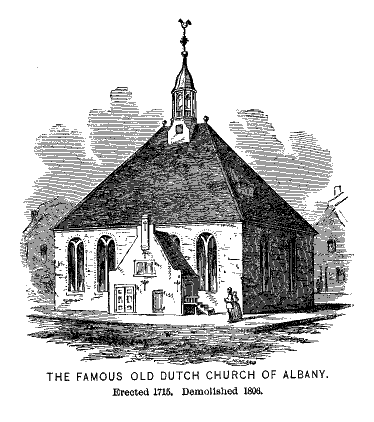
The destruction of Albany’s structural heritage is not a new topic. William Kent, in addressing the changes that had overcome Albany in the early decades of the 19th century, lamented the march of modernity. In 1854, he was complaining:
“The architecture of Holland and ancient Albany was not that of Virtuvius [sic] or Palladio; but I hope you all regret with me that the sweep of modern improvement has unnecessarily abolished every vestige of those queer, but interesting buildings, which marked an epoch in our history, and the predominance of national characteristics, now submerged, for ever in the mingling of the people, forming new America. I suppose there is scarcely a person in this assembly who remembers, as I do, the old Dutch Church at the foot of State-street. I cannot help regretting this curious structure, although I admit, that no modern architect could erect so ugly a building, and although its removal has created, perhaps, the noblest street in an American city. But why was the old Vanderheyden Palace, with its quaint gables, and elaborate, if fantastic, ornaments, allowed to disappear? And where were the archaeologists of Albany, when innovators tore down the harmless old building at Lydius’s Corner, constructed of bricks brought years and years ago from Holland?
It is, I know full well, useless to resist or lament change and innovation. Yet an old inhabitant returning after years of absence, to Albany, sighs for the departed beauties of its environs. Where is the Patroon’s Creek, once umbrageous with shade, and intricate with sylvan labyrinth? It is turned into a conduit! Where is the beautiful cascade, which we, rather ambitiously, styled the Falls of Tivoli? It has become a water-tank. Where are the sanded beach and the willowy banks of the river? They have become a rail-road depot and a canal basin. What has become of the Cataract of the Cohoes, so secluded, so solitary, so awe-inspiring, where, as Thomas Moore sings,
‘From rise of morn ’till set of sun,
He saw the mighty Mohawk run”?
It is metamorphosed to a woolen factory.’”
Kent’s lost Albany was, in fact, lost to the Albany that many are now trying to preserve, hoping to have learned from the past, but faced with the same utter disregard for our own heritage.
“All those things are doubtless useful, necessary perhaps, certainly utilitarian and money-making, but it is a relief to the old Albanian to gaze on the bolder features of your landscape, and at least recognize landmarks, which defy the puny encroachments of man. He is sincerely grateful, that you cannot shut out the Green Mountains; that you cannot level the Helderberghs; that you cannot essentially alter the majestic sweep of your matchless river;
and that no engineer can dig down the everlasting Catskills.”
So who was William Kent? He was born in Albany in 1892, graduated from Union College and studied law and practised in New York City. He was appointed justice of the Supreme Court of New York by Governor Seward and served until 1846, when he resigned to accept the Royall
professorship of law in Harvard college. He resigned in 1847 owing to his father’s ill health, and returned to New York City. He was a member of the American Philosophical Society and a member of the council of the University of the City of New York. He died at Fishkill Landing, N.Y., Jan. 14, 1861.

Leave a Reply